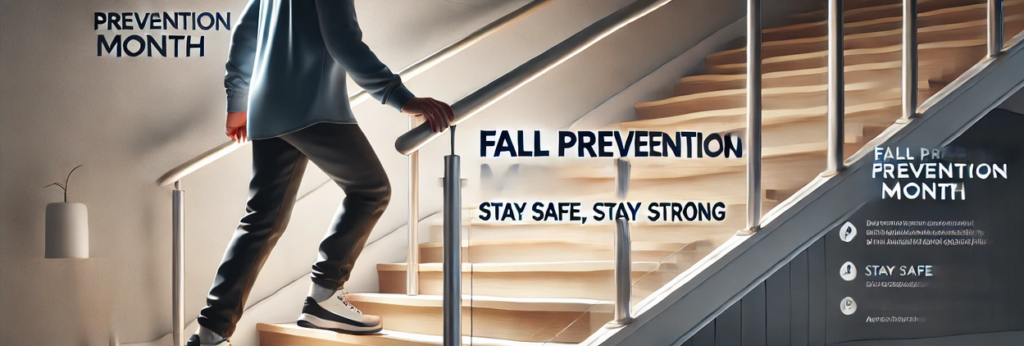Falls are among the leading causes of injury in both workplaces and homes, making fall prevention a critical topic to address. Every year, Fall Prevention Month aims to raise awareness and promote practices that reduce fall-related injuries.

This article provides actionable insights and tips for preventing falls at home, at work, and in public spaces, ensuring the safety and well-being of everyone.
The Importance of Fall Prevention
Falls can have devastating consequences, particularly for older adults and workers in high-risk occupations. According to the World Health Organization (WHO), falls are the second leading cause of unintentional injury deaths worldwide.
In Canada, the Public Health Agency of Canada (PHAC) highlights that falls are the leading cause of injury among seniors, with significant physical, emotional, and financial impacts.
Whether you’re a safety professional or a family caregiver, understanding the importance of fall prevention is crucial to protecting lives and reducing healthcare costs.
Common Causes of Falls
Falls can result from a wide range of hazards, including:
- Slippery or uneven surfaces (e.g., wet floors or cracked sidewalks)
- Poor lighting in stairways and hallways
- Clutter and obstacles in walking paths
- Lack of proper safety equipment in workplaces
- Health issues such as poor vision, balance problems, or medication side effects
Fall Prevention Tips for the Workplace
1. Conduct Regular Risk Assessments
Identify and address potential hazards before they cause harm. Inspect walkways, stairways, and high-traffic areas for risks.
2. Use Proper Fall Protection Equipment
For workers in construction, warehousing, and similar industries, personal fall arrest systems (PFAS) and guardrails are essential. Ensure equipment is regularly inspected and maintained.
3. Keep Walkways Clear and Well-Lit
Remove obstacles and provide adequate lighting to reduce the risk of trips and slips. Pay special attention to areas with frequent foot traffic.
4. Train Employees on Fall Prevention
Offer regular training sessions on how to identify hazards, use equipment correctly, and respond to incidents. This empowers employees to take ownership of their safety.
5. Install Anti-Slip Flooring and Mats
In high-risk areas such as kitchens or entryways, use non-slip materials to reduce the risk of slipping, especially in wet conditions.
Fall Prevention Tips for Homes and Public Spaces

1. Remove Clutter and Hazards
Keep living spaces tidy by removing tripping hazards such as loose rugs, electrical cords, and toys from walking paths.
2. Install Handrails and Grab Bars
Provide support in high-risk areas such as bathrooms and staircases. Handrails and grab bars can significantly reduce the risk of falling.
3. Improve Lighting
Ensure hallways, staircases, and entryways are well-lit. Use nightlights in bedrooms and bathrooms to help prevent nighttime falls.
4. Wear Proper Footwear
Shoes with good traction and support can help prevent slips and falls, especially for older adults. Avoid high heels, loose slippers, or shoes with smooth soles.
5. Regular Health Check-Ups
Encourage regular vision and hearing tests, and discuss any balance or mobility concerns with a healthcare professional. Physical therapy and exercise programs can improve strength and coordination, reducing fall risks.
Fall Prevention for Older Adults
Older adults are particularly vulnerable to falls due to physical changes, underlying health conditions, and medication use. Some specific strategies for preventing falls among seniors include:
- Home modifications such as grab bars, non-slip mats, and stair lifts.
- Exercise programs like tai chi, which improve balance and coordination.
- Medication reviews to minimize side effects that could affect balance.
- Assistive devices like canes and walkers for additional support.
Fall Prevention Month Campaign Ideas
Fall Prevention Month provides an excellent opportunity to spread awareness and promote fall safety initiatives.

Here are some campaign ideas:
- Host Safety Workshops: Offer training sessions for employees or community members on fall prevention strategies.
- Create Awareness Posters: Display safety tips and reminders in workplaces and public areas.
- Social Media Campaigns: Share fall prevention tips and success stories using hashtags like #FallPreventionMonth and #StaySafeFromFalls.
- Distribute Safety Checklists: Provide a checklist to help individuals assess and improve the safety of their homes or workplaces.
Resources for Fall Prevention
- Public Health Agency of Canada (PHAC) – Fall Prevention Guide
- Centers for Disease Control and Prevention (CDC) – Fall Prevention Toolkit
- OHSE.ca – Workplace Safety Resources
Conclusion
Fall prevention is a shared responsibility that requires vigilance and proactive measures. By incorporating these safety tips at home and work, you can reduce the risk of falls and protect the well-being of your loved ones and colleagues.
Fall Prevention Month is an ideal time to assess and improve your safety practices—let’s work together to prevent falls and create safer environments for everyone.
Stay informed, stay safe, and help spread the word about fall prevention!


No comments yet